
Buckeystown is an unincorporated community and census-designated place (CDP) in Frederick County, Maryland, United States. As of the 2010 census the population was 1,019. Buckeystown Historic District and Buckingham House and Industrial School Complex were listed on the National Register of Historic Places in 1982. Carrollton Manor was listed in 1997. Former Congressman Roscoe Bartlett lives on a farm in the town.
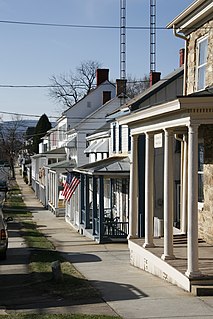
The Middletown Historic District comprises the historic center of Middletown, Maryland. Middletown became the chief community in the Middletown Valley in the late 18th century, retaining its importance until the 1930s, when the expanding influence of Frederick, Maryland, the construction of a bypass on US 40 and the abandonment of the Hagerstown and Frederick Railway produced a gradual decline. The historic district preserves many mid-19th-century buildings in the central downtown area. To the east, the district includes early 20th-century houses built along the trolley right-of-way, forming a streetcar suburb. The Airview Historic District includes a related area of early 20th century development to the east of town along the National Pike, separated from the main district by a section of newer development.
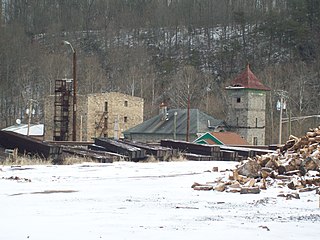
Daniels Mill is a historic mill complex located at Daniels, Howard County, Maryland, in a sheltered, wooded valley of the upper Patapsco River. The complex consists of seven early industrial structures, several concrete block and brick structures of 20th century date, and Gary Memorial United Methodist Church, a granite church built in the High Victorian Gothic style with an off-center tower entrance on the west gable. South of the church is a small cemetery.

The Savage Mill Historic District is a national historic district located at Savage, Howard County, Maryland. The district comprises the industrial complex of Savage Mill and the village of workers' housing to the north of the complex.
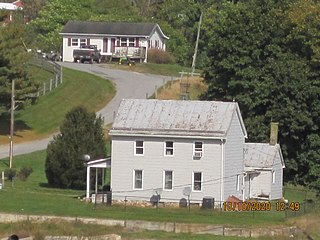
The Drummine Farm is a historic home and farm complex located at New Market, Frederick County, Maryland, United States. The main house was constructed about 1790 and is a 2+1⁄2-story structure of uncoursed fieldstone. The house retains Georgian stylistic influences in exterior and interior decorative detailing. The farm complex structures include a stone tenant house dated 1816, and four additional fieldstone buildings from the early 19th century: a smokehouse, a water storage house, a garden outhouse, and a large bank barn. Wooden farm buildings include a calf shed and a wagon shed with corn cribs from the late 19th century, a dairy barn with three cement stave silos from the 1930s, several sheds and garages, and a large pole barn.
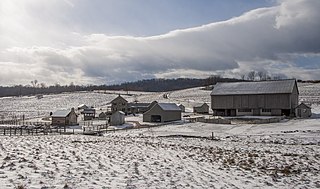
Peter of P. Grossnickel Farm is a historic home and farm complex located at Myersville, Maryland, Frederick County. It consists of a mid-19th-century, Greek Revival farmhouse and 13 related buildings and structures. The house is a 2+1⁄2-story stone center-passage house on a limestone foundation, with a 1+1⁄2-story kitchen wing and 18-inch-thick (460 mm) walls. The house was built between 1840 and 1850. Also on the property is an 1881 tenant house with corresponding barn, spring house, and washhouse / privy; an 1884–1897 bank barn; a pre-1830 granary; a 19th-century wood shed; late-19th-century hog pen / chicken house; a pre-1830 beehive oven; a late-19th-century smokehouse; a spring house with a Late Victorian cottage addition; and early-20th-century concrete block milk house; and a log summer kitchen of unknown date. The Grossnickel family was a German American family who were instrumental in the establishment of the Grossnickel Church of the Brethren.

Harris Farm is a historic home and farm complex located at Walkersville, Frederick County, Maryland, United States. The main house was built in 1855, and is a three-story center plan house in predominantly late Greek Revival syle, with some Italianate elements. The agricultural complex consists of a bank barn with an attached granary; a second frame barn that shares an animal yard with the bank barn; a row of frame outbuildings including a converted garage, a workshop, and a chicken house. There is also a drive-through double corn crib; and a frame pig pen from 1914. The 20th-century buildings consist of a frame poultry house, a dairy barn with milk house and two silos, and an octagonal chicken coop. A lime kiln is located on the edge of the property. The property is preserved as part of the Walkersville Heritage Farm Park.
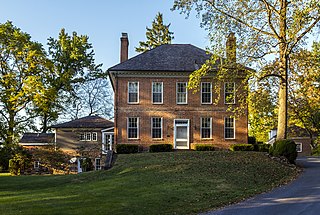
Woods Mill Farm is a historic home and farm complex located at Woodsboro, Frederick County, Maryland. It includes the Colonel Joseph Wood House and associated buildings. The house is an unusual example of an 18th-century brick, Georgian style manor house, built about 1770. It is a two-story brick dwelling with a hipped roof and inside end chimneys. The property also includes two distinctive outbuildings: a two-story, two-room stone and brick smokehouse with a gable roof and a brick end barn built about 1830. The original owner of this property was Col. Joseph Wood, founder of Woodsberry.
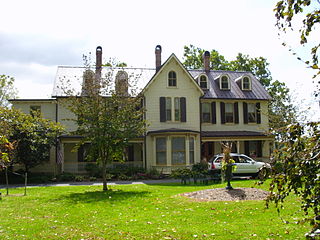
The Highland Lodge, also known as Pequea, is a historic home and resort building complex located at Frederick, Frederick County, Maryland, United States. It consists of a large Victorian period frame house centered at the end of a circular driveway, and its complement of outbuildings. The house is large and rambling and considered eclectic in style with a prominent central projecting gable. The property includes a frame stable and carriage house, now garages; a small frame barn; a small log dwelling moved to the property in the early 20th century; a frame summer kitchen and a frame secondary dwelling. It was developed originally in 1881 as a summer home for John H. Williams, a wealthy and influential Frederick attorney and banker.
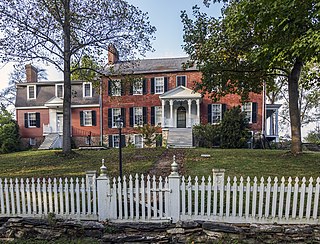
Hopewell is a set of historic homes and farm complexes located at Union Bridge, Carroll County, Maryland, United States. It consists of four related groupings of 19th century farm buildings. The Hopewell complex consists of two historic farms: Hopewell and the smaller F.R. Shriner Farm.

The Victor Cullen Center, Old Administration Building is a historic building located at Sabillasville, Frederick County, Maryland, United States. It is a 2+1⁄2-story, stone and frame Colonial Revival style structure located on a hillside with four stone chimneys, two on each gable end. The building was built originally to house the Maryland Tuberculosis Sanitorium, the first state sponsored institution of its type in Maryland. It was designed by the architectural firm Wyatt & Nolting.

The Victor Cullen School Power House is a historic power house building located at Sabillasville, Frederick County, Maryland. It is a 2+1⁄2-story, Renaissance Revival stone structure, with a hip roof and a fully exposed basement. The building was built originally as part of the Maryland Tuberculosis Sanitorium, the first state sponsored institution of its type in Maryland. It was designed by architects Wyatt & Nolting.
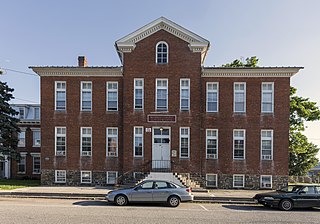
St. Euphemia's School and Sisters' House is a historic school building and convent located at Emmitsburg, Frederick County, Maryland. It is a late-19th century school complex that consists of two attached brick buildings: a two and half story school building built about 1890, and a house that was used as a convent and built about 1860.
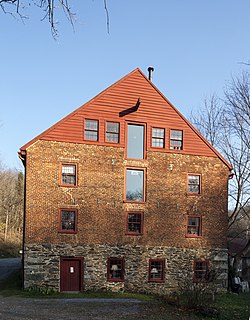
Lewis Mill Complex is a historic grist mill complex located at Jefferson, Frederick County, Maryland. The complex consists of seven standing structures, a house foundation, and the remains of an earlier millrace. It centers on an early 19th-century three-story brick mill structure with a gabled roof. The mill complex served German immigrant farmers in Middletown Valley between 1810 and the 1920s. It was rehabilitated in 1979-1980 for use as a pottery shop. Also in the complex are a stuccoed log house and log springhouse built about; a frame wagon shed and corn crib structure and frame barn dating from the late 19th century; and early 20th century cattle shelter and a frame garage.
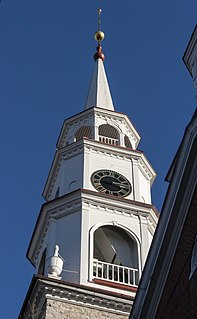
The Frederick Historic District is a national historic district in Frederick, Maryland. The district encompasses the core of the city and contains a variety of residential, commercial, ecclesiastical, and industrial buildings dating from the late 18th century to 1941. Notable are larger detached dwellings in the Queen Anne and American Foursquare architectural styles of the late 19th and early 20th centuries The churches reflect high style architecture ranging from Gothic and Greek Revival to Richardsonian Romanesque and Colonial Revival. The east side of the district includes the industrial buildings.

The Mount Airy Historic District is a national historic district in Mount Airy, located in Carroll and Frederick County, Maryland. The district comprises a cohesive group of commercial, residential, and ecclesiastical buildings dating from the late 19th through early 20th centuries. The brick Baltimore and Ohio Railroad station, designed by E. Francis Baldwin and constructed in 1882, represents the town's origin as an early transportation center for the region, which dates back as early as 1838. A group of early-20th century commercial structures represent the rebuilding of Mount Airy's downtown after a series of fires between 1903 and 1926. The residential areas are characterized by houses illustrating vernacular forms and popular stylistic influences of the late 19th and early 20th century. Three churches are located within the district.

Rufus Wilson Complex is a group of historic buildings located at Clear Spring, Washington County, Maryland, United States. The property includes a complex of mid-late 19th century buildings which create the center of a small rural settlement named Conococheague located on the National Road. The main house is a large brick dwelling with a mansard roof. This house incorporates a 2+1⁄2-story limestone dwelling built about 1850 by Rufus Wilson, which was enlarged to its present Second Empire style in the last quarter of the 19th century. Adjacent to the house is a brick post office and store, built about 1880 by Wilson, with an attached feed room of frame construction with weatherboard siding. A carriage house built about 1882 is located immediately behind the store and a bank barn and grazing area are located at the rear of these buildings. Also on the property is a small frame corn crib.
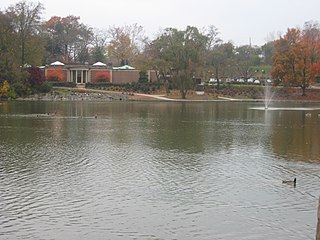
Hagerstown City Park is a public urban park just southwest of the central business district of Hagerstown, Maryland, United States. The park is located at the junction of Virginia Avenue, Key Street, Walnut Street, Prospect Street, and Memorial Boulevard.

Creagerstown is an unincorporated community in Frederick County, Maryland, United States. It is playfully known by its residents as "4 miles from everywhere" because of its situation at 4 miles (6.4 km) from Thurmont, Woodsboro, Rocky Ridge, and Lewistown.

Johnsville is an unincorporated community in Frederick County, Maryland, United States. It is located approximately halfway between Libertytown and Union Bridge along Maryland Route 75. The Kitterman-Buckey Farm was listed on the National Register of Historic Places in 2005.
























